2013 YAMAHA YZ125LC weight
[x] Cancel search: weightPage 8 of 168
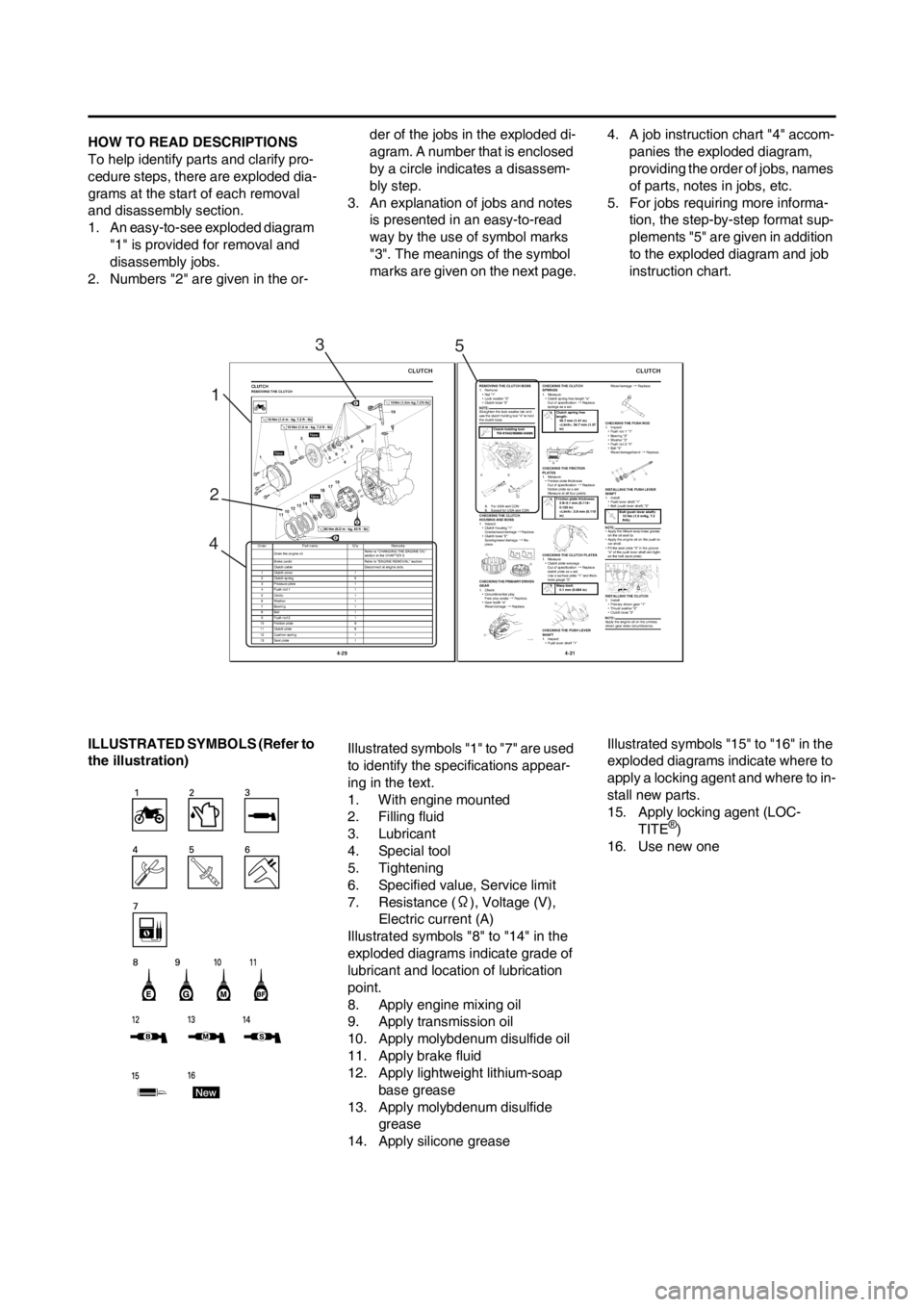
HOW TO READ DESCRIPTIONS
To help identify parts and clarify pro-
cedure steps, there are exploded dia-
grams at the start of each removal
and disassembly section.
1. An easy-to-see exploded diagram
"1" is provided for removal and
disassembly jobs.
2. Numbers "2" are given in the or-der of the jobs in the exploded di-
agram. A number that is enclosed
by a circle indicates a disassem-
bly step.
3. An explanation of jobs and notes
is presented in an easy-to-read
way by the use of symbol marks
"3". The meanings of the symbol
marks are given on the next page.4. A job instruction chart "4" accom-
panies the exploded diagram,
providing the order of jobs, names
of parts, notes in jobs, etc.
5. For jobs requiring more informa-
tion, the step-by-step format sup-
plements "5" are given in addition
to the exploded diagram and job
instruction chart.
ILLUSTRATED SYMBOLS (Refer to
the illustration)Illustrated symbols "1" to "7" are used
to identify the specifications appear-
ing in the text.
1. With engine mounted
2. Filling fluid
3. Lubricant
4. Special tool
5. Tightening
6. Specified value, Service limit
7. Resistance (Ω), Voltage (V),
Electric current (A)
Illustrated symbols "8" to "14" in the
exploded diagrams indicate grade of
lubricant and location of lubrication
point.
8. Apply engine mixing oil
9. Apply transmission oil
10. Apply molybdenum disulfide oil
11. Apply brake fluid
12. Apply lightweight lithium-soap
base grease
13. Apply molybdenum disulfide
grease
14. Apply silicone greaseIllustrated symbols "15" to "16" in the
exploded diagrams indicate where to
apply a locking agent and where to in-
stall new parts.
15. Apply locking agent (LOC-
TITE
®)
16. Use new one
1
23
45
Page 17 of 168
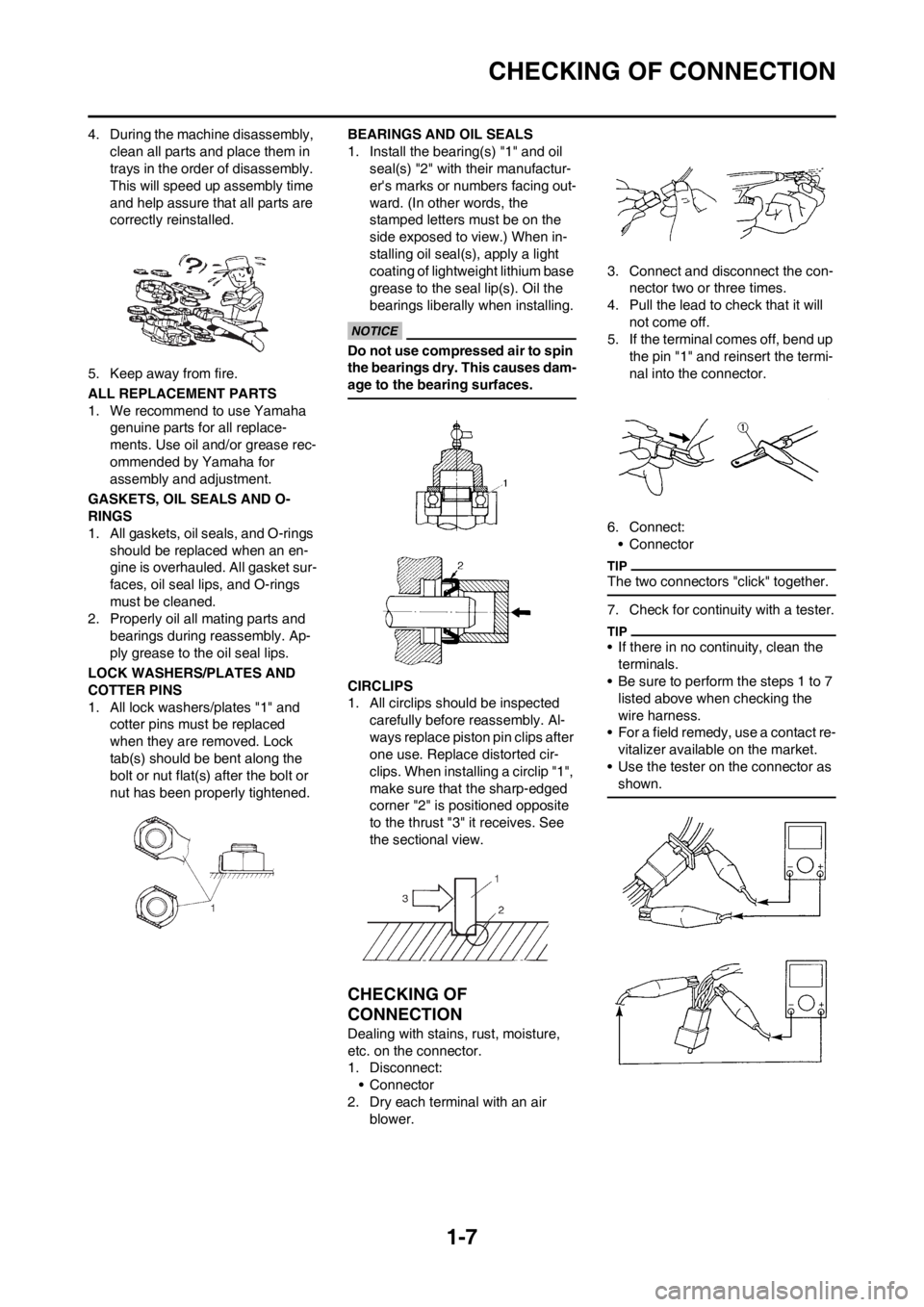
1-7
CHECKING OF CONNECTION
4. During the machine disassembly,
clean all parts and place them in
trays in the order of disassembly.
This will speed up assembly time
and help assure that all parts are
correctly reinstalled.
5. Keep away from fire.
ALL REPLACEMENT PARTS
1. We recommend to use Yamaha
genuine parts for all replace-
ments. Use oil and/or grease rec-
ommended by Yamaha for
assembly and adjustment.
GASKETS, OIL SEALS AND O-
RINGS
1. All gaskets, oil seals, and O-rings
should be replaced when an en-
gine is overhauled. All gasket sur-
faces, oil seal lips, and O-rings
must be cleaned.
2. Properly oil all mating parts and
bearings during reassembly. Ap-
ply grease to the oil seal lips.
LOCK WASHERS/PLATES AND
COTTER PINS
1. All lock washers/plates "1" and
cotter pins must be replaced
when they are removed. Lock
tab(s) should be bent along the
bolt or nut flat(s) after the bolt or
nut has been properly tightened.BEARINGS AND OIL SEALS
1. Install the bearing(s) "1" and oil
seal(s) "2" with their manufactur-
er's marks or numbers facing out-
ward. (In other words, the
stamped letters must be on the
side exposed to view.) When in-
stalling oil seal(s), apply a light
coating of lightweight lithium base
grease to the seal lip(s). Oil the
bearings liberally when installing.
Do not use compressed air to spin
the bearings dry. This causes dam-
age to the bearing surfaces.
CIRCLIPS
1. All circlips should be inspected
carefully before reassembly. Al-
ways replace piston pin clips after
one use. Replace distorted cir-
clips. When installing a circlip "1",
make sure that the sharp-edged
corner "2" is positioned opposite
to the thrust "3" it receives. See
the sectional view.
CHECKING OF
CONNECTION
Dealing with stains, rust, moisture,
etc. on the connector.
1. Disconnect:
• Connector
2. Dry each terminal with an air
blower.3. Connect and disconnect the con-
nector two or three times.
4. Pull the lead to check that it will
not come off.
5. If the terminal comes off, bend up
the pin "1" and reinsert the termi-
nal into the connector.
6. Connect:
• Connector
The two connectors "click" together.
7. Check for continuity with a tester.
• If there in no continuity, clean the
terminals.
• Be sure to perform the steps 1 to 7
listed above when checking the
wire harness.
• For a field remedy, use a contact re-
vitalizer available on the market.
• Use the tester on the connector as
shown.
Page 25 of 168

2-1
GENERAL SPECIFICATIONS
SPECIFICATIONS
GENERAL SPECIFICATIONS
Model name:YZ125D (USA, CDN, AUS, NZ)
YZ125 (EUROPE, ZA)
Model code number: 1SR5 (USA, CDN)
1SR6 (EUROPE)
1SR8 (AUS, NZ, ZA)
Dimensions: USA, AUS, NZ, ZAEUROPE, CDN
Overall length 2,135 mm (84.1 in) 2,139 mm (84.2 in)
Overall width 827 mm (32.6 in)←
Overall height 1,315 mm (51.8 in) 1,318 mm (51.9 in)
Seat height 997 mm (39.3in)998 mm (39.3 in)
Wheelbase 1,443 mm (56.8 in)←
Minimum ground clearance 386 mm (15.2 in)388 mm (15.3 in)
Weight: Curb weight 94 kg (207 lb)
Engine: Engine type Liquid cooled 2-stroke, gasoline
Cylinder arrangement Single cylinder
Displacement 124 cm
3 (4.36 Imp oz, 4.19 US oz)
Bore × stroke 54 × 54.5 mm (2.1 × 2.1 in)
Compression ratio 8.6–10.7 : 1
Starting system Kick starter
Lubrication system: Premix (30 : 1)(YAMALUBE 2-R)
Oil type or grade (2-stroke): Transmission oil Recommended brand: YAMALUBE SAE10W-40
API service SG type or higher
JASO standard MA
Periodic oil change 0.66 L (0.58 Imp qt, 0.69 US qt)
Total amount 0.70 L (0.62 Imp qt, 0.74 US qt)
Coolant capacity (including all routes): 0.9 L (0.79 Imp qt, 0.95 US qt)
Air filter: Wet type element
Fuel: Type Premium unleaded gasoline on ly with a research octane
number of 95 or higher.
Tank capacity 8.0 L (1.76 Imp gal, 2.11 US gal)
Carburetor: Type/Manufacturer TMX χ38SS/MIKUNI
Spark plug: Type/Manufacturer BR9EVX/NGK (resistance type)
Gap 0.6–0.7 mm (0.024–0.028 in)
Clutch type: Wet, multiple-disc
2
Page 36 of 168
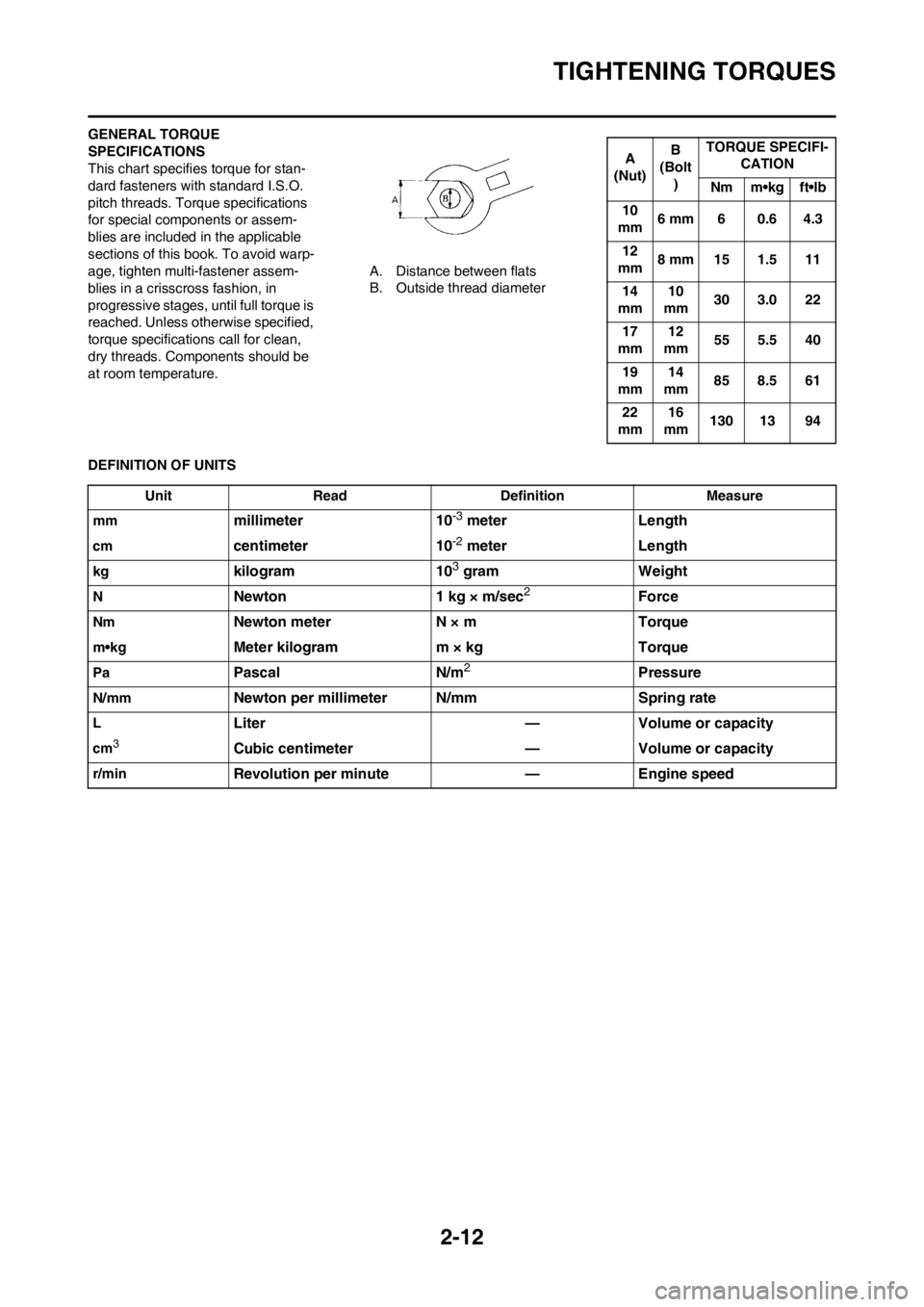
2-12
TIGHTENING TORQUES
GENERAL TORQUE
SPECIFICATIONS
This chart specifies torque for stan-
dard fasteners with standard I.S.O.
pitch threads. Torque specifications
for special components or assem-
blies are included in the applicable
sections of this book. To avoid warp-
age, tighten multi-fastener assem-
blies in a crisscross fashion, in
progressive stages, until full torque is
reached. Unless otherwise specified,
torque specifications call for clean,
dry threads. Components should be
at room temperature.A. Distance between flats
B. Outside thread diameter
DEFINITION OF UNITS
A
(Nut)B
(Bolt
)TORQUE SPECIFI-
CATION
Nm m•kg ft•lb
10
mm6 mm 6 0.6 4.3
12
mm8 mm 15 1.5 11
14
mm10
mm30 3.0 22
17
mm12
mm55 5.5 40
19
mm14
mm85 8.5 61
22
mm16
mm130 13 94
Unit Read Definition Measure
mm
millimeter 10-3 meter Length
cmcentimeter 10-2 meter Length
kgkilogram 103 gram Weight
NNewton 1 kg × m/sec2Force
NmNewton meter N × m Torque
m•kgMeter kilogram m × kg Torque
PaPascal N/m2Pressure
N/mmNewton per millimeter N/mm Spring rate
LLiter — Volume or capacity
cm3Cubic centimeter — Volume or capacity
r/minRevolution per minute — Engine speed
Page 61 of 168
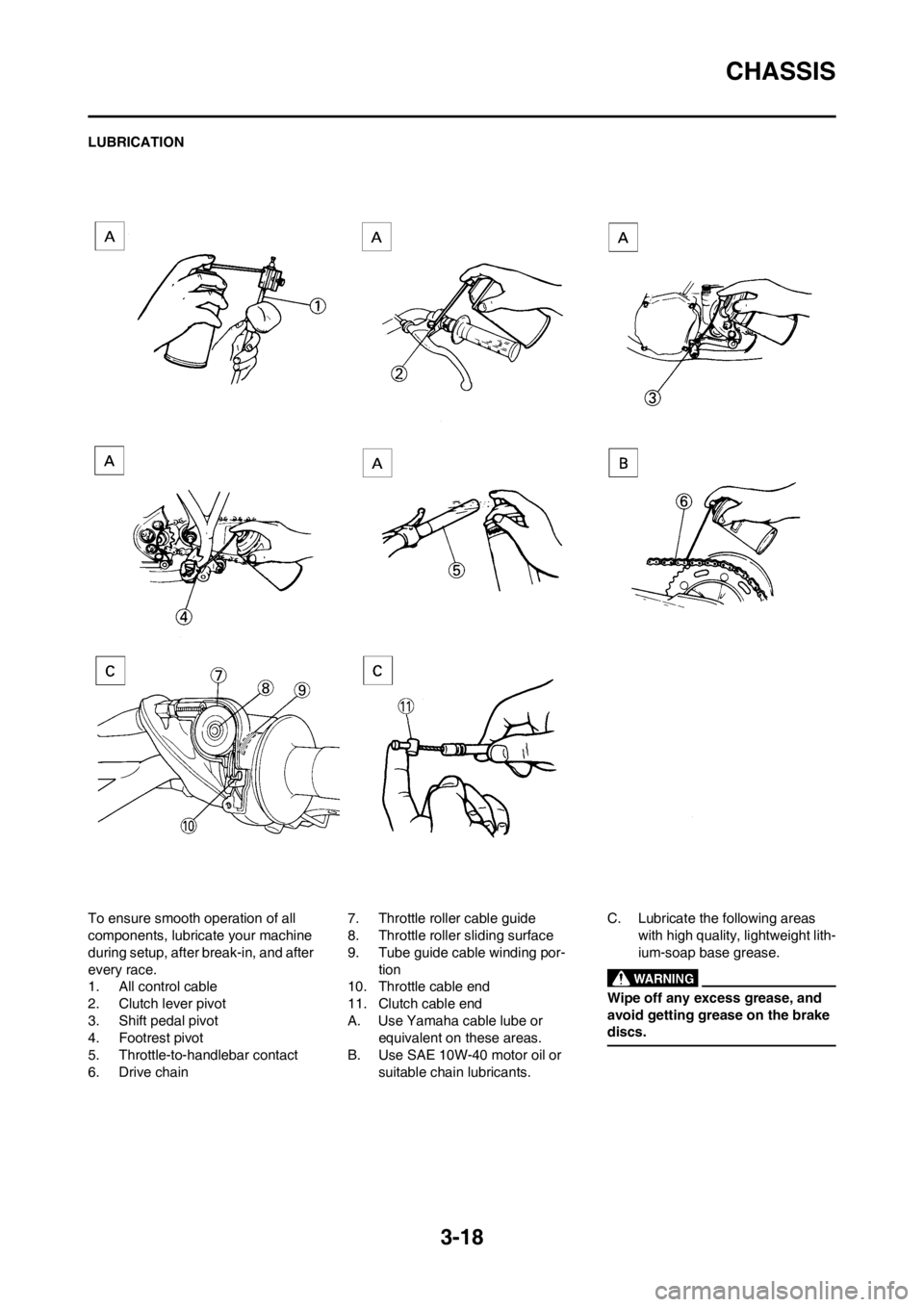
3-18
CHASSIS
LUBRICATION
To ensure smooth operation of all
components, lubricate your machine
during setup, after break-in, and after
every race.
1. All control cable
2. Clutch lever pivot
3. Shift pedal pivot
4. Footrest pivot
5. Throttle-to-handlebar contact
6. Drive chain7. Throttle roller cable guide
8. Throttle roller sliding surface
9. Tube guide cable winding por-
tion
10. Throttle cable end
11. Clutch cable end
A. Use Yamaha cable lube or
equivalent on these areas.
B. Use SAE 10W-40 motor oil or
suitable chain lubricants.C. Lubricate the following areas
with high quality, lightweight lith-
ium-soap base grease.
Wipe off any excess grease, and
avoid getting grease on the brake
discs.
Page 90 of 168
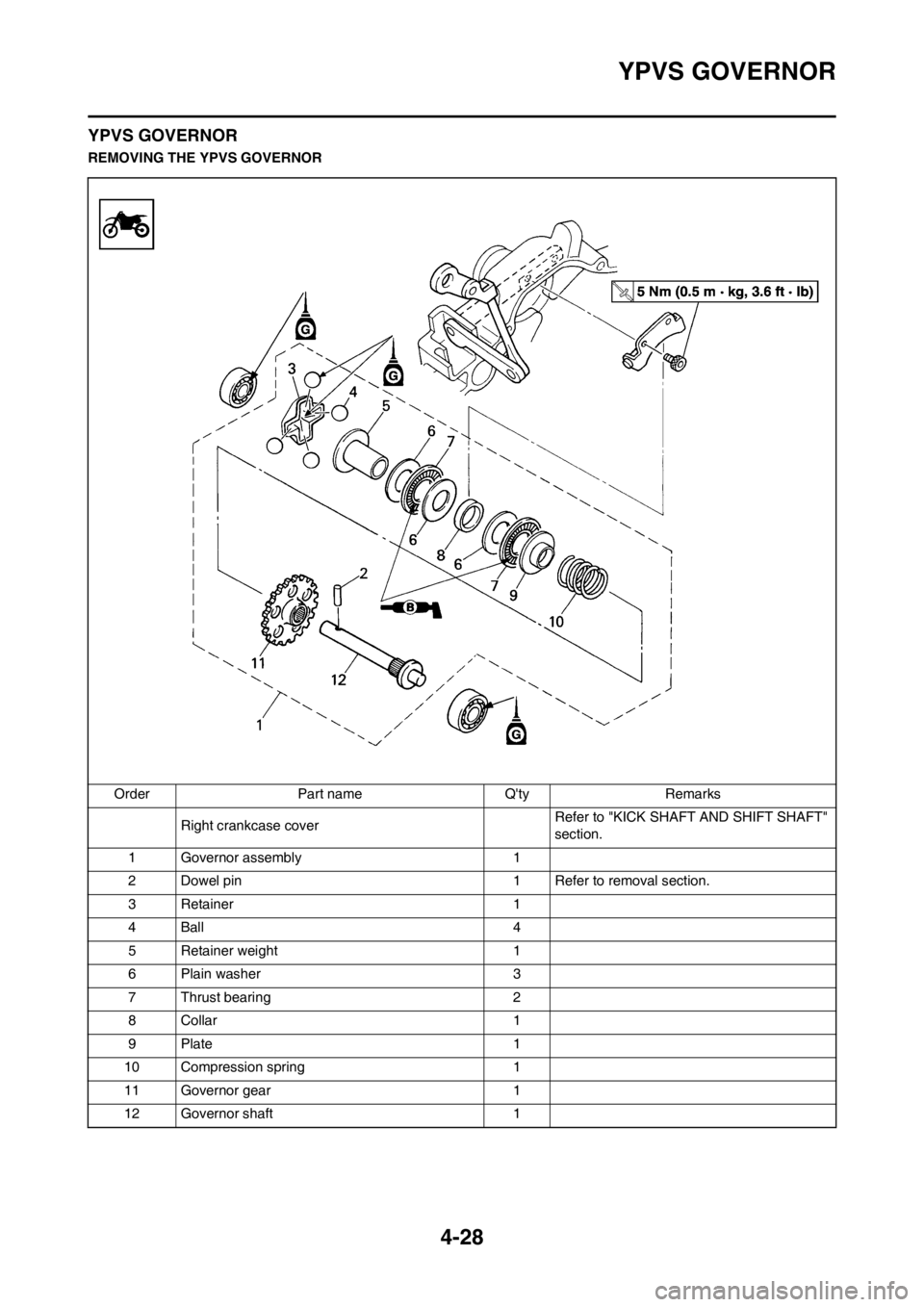
4-28
YPVS GOVERNOR
YPVS GOVERNOR
REMOVING THE YPVS GOVERNOR
Order Part name Q'ty Remarks
Right crankcase coverRefer to "KICK SHAFT AND SHIFT SHAFT"
section.
1 Governor assembly 1
2 Dowel pin 1 Refer to removal section.
3 Retainer 1
4Ball 4
5 Retainer weight 1
6 Plain washer 3
7 Thrust bearing 2
8 Collar 1
9Plate 1
10 Compression spring 1
11 Governor gear 1
12 Governor shaft 1
Page 91 of 168
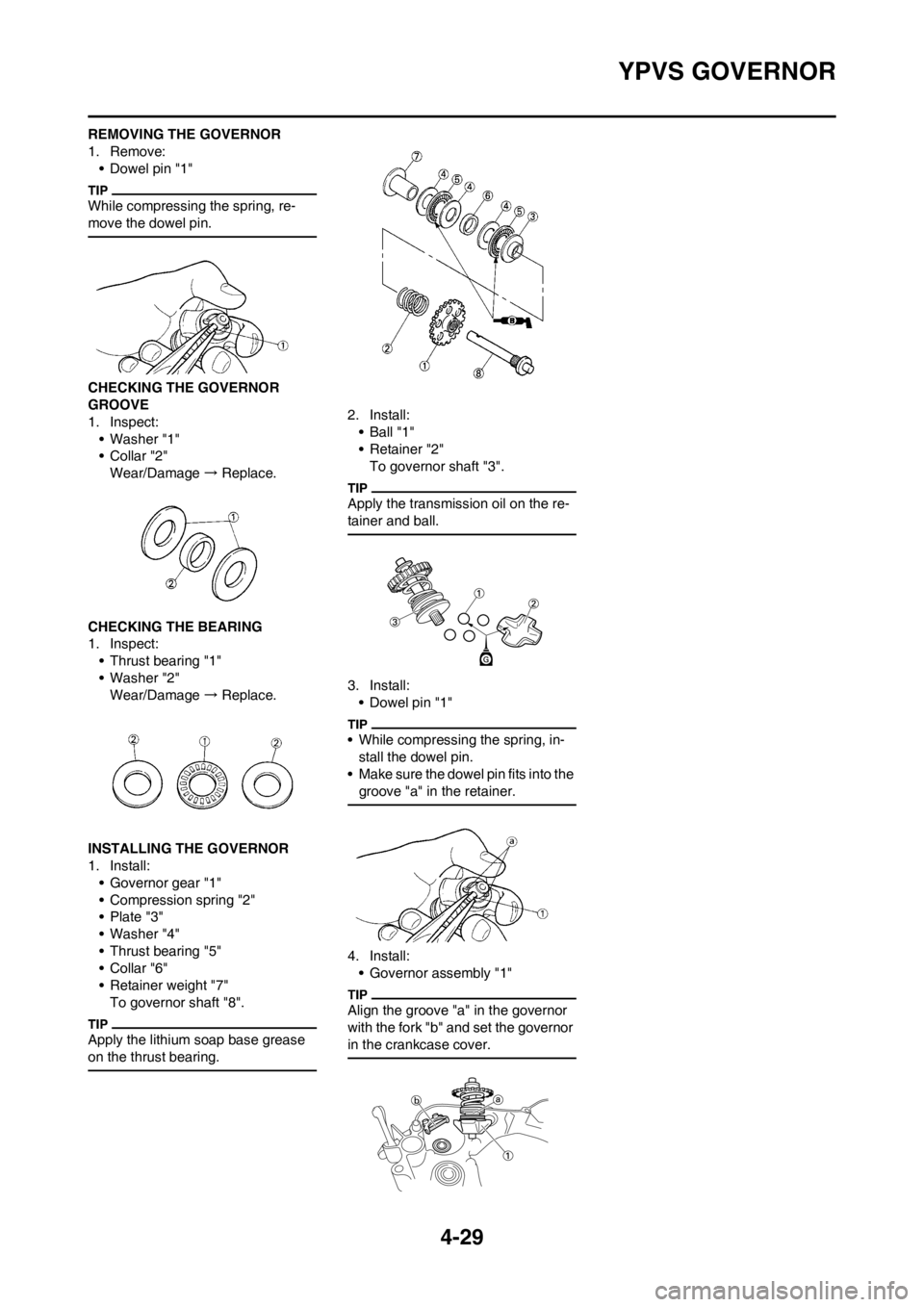
4-29
YPVS GOVERNOR
REMOVING THE GOVERNOR
1. Remove:
• Dowel pin "1"
While compressing the spring, re-
move the dowel pin.
CHECKING THE GOVERNOR
GROOVE
1. Inspect:
• Washer "1"
•Collar "2"
Wear/Damage → Replace.
CHECKING THE BEARING
1. Inspect:
• Thrust bearing "1"
• Washer "2"
Wear/Damage → Replace.
INSTALLING THE GOVERNOR
1. Install:
• Governor gear "1"
• Compression spring "2"
• Plate "3"
• Washer "4"
• Thrust bearing "5"
•Collar "6"
• Retainer weight "7"
To governor shaft "8".
Apply the lithium soap base grease
on the thrust bearing.
2. Install:
• Ball "1"
• Retainer "2"
To governor shaft "3".
Apply the transmission oil on the re-
tainer and ball.
3. Install:
• Dowel pin "1"
• While compressing the spring, in-
stall the dowel pin.
• Make sure the dowel pin fits into the
groove "a" in the retainer.
4. Install:
• Governor assembly "1"
Align the groove "a" in the governor
with the fork "b" and set the governor
in the crankcase cover.